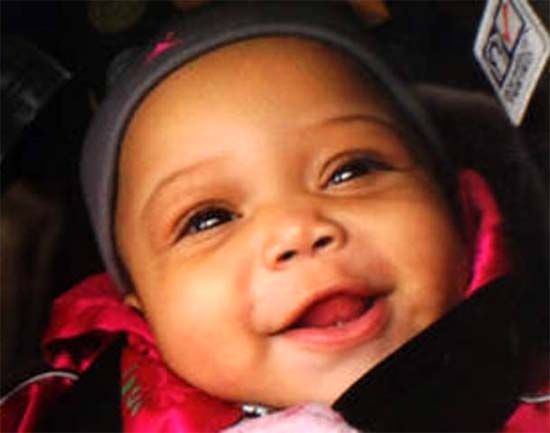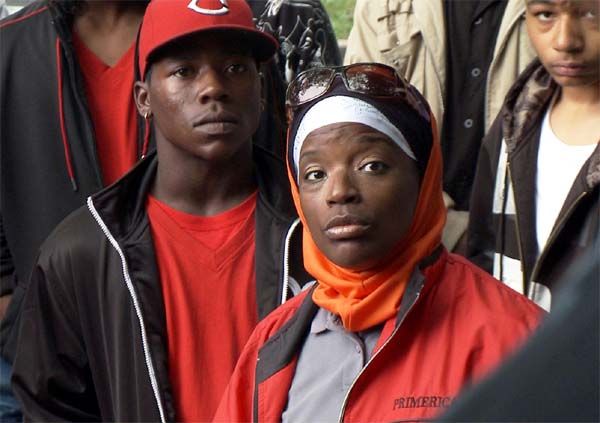The face of six month old Jonylah Watkins, shot in Chicago March 11, 2013. Died March 12.
It is very hard to look at the faces of babies who are murdered. It hurts when we read about, or know anyone killed violently, but somehow it hurts even more when we see a child who barely had a chance to live taken away by a bullet.
Jonylah Watkins was shot sitting in her dad’s lap, when he was parked in a mini van in the Woodlawn section of Chicago. Her father, Jonathan Watkins, shot multiple times, survived. Though initial news reports were garbled, and contained misinformation, the end result is the same. Another child is dead.
Over 1,000 mourners attended her funeral in Chicago.
Her grandmother, Mary Young gave a eulogy addressing her neighbors and fellow citizens
“My neighbors of Chicago, what have thou done?” Young said, standing at a podium overlooking her granddaughter’s tiny casket. “You brought in the darkness, removed the sun. It’s now obvious the time has come when killing one another will no longer be tolerated by anyone.”
I know the conversation nationally is about gun-control and gun violence, and stopping the killing via legislation.
Today, I want to take a look at efforts being made in urban communities to address the problems from the inside out.
There are no magical short term solutions. There is no one factor that can cure the ills facing the poor who are locked into inner city situations. The contributing variables are a complex mixture of systemic racism, high unemployment, de-facto segregation in housing and education, the so-called war on drugs and prison pipeline contributing to street gang activity…the list is long, and the fix is going to take even longer.
I think often of something said by Eldridge Cleaver, “You are either part of the solution or part of the problem.” Too often we fail to appreciate and support local efforts to deal with the problems that beset them.
Imho, contrary to the rhetoric spouted by police honchos like Bill Bratton, and some big city mayors like Michael Bloomberg, the solution is not locking more people up, and stop and frisk programs harassing young men of color on the streets.
Efforts that seem to show far better short term results are those that combine a mixture of community policing and community member activism.
One such effort, that is being implemented in multiple urban communities, began in Chicago, and is documented in the award winning documentary film “The Interrupters”
The Interrupters tells the moving and surprising stories of three Violence Interrupters who try to protect their Chicago communities from the violence they once employed. From acclaimed director Steve James and bestselling author Alex Kotlowitz, this film is an unusually intimate journey into the stubborn persistence of violence in our cities. Shot over the course of a year out of Kartemquin Films, The Interrupters captures a period in Chicago when it became a national symbol for the violence in our cities. During that period, the city was besieged by high-profile incidents, most notably the brutal beating of Derrion Albert, a Chicago High School student, whose death was caught on videotape.
The film’s main subjects work for an innovative organization, CeaseFire. It was founded by an epidemiologist, Gary Slutkin, who believes that the spread of violence mimics the spread of infectious diseases, and so the treatment should be similar: go after the most infected, and stop the infection at its source. One of the cornerstones of the organization is the “Violence Interrupters” program, created by Tio Hardiman, who heads the program. The Interrupters – who have credibility on the streets because of their own personal histories – intervene in conflicts before they explode into violence.
In The Interrupters, Ameena Matthews, whose father is Jeff Fort, one of the city’s most notorious gang leaders, was herself a drug ring enforcer. But having children and finding solace in her Muslim faith pulled her off the streets and grounded her. In the wake of Derrion Albert’s death, Ameena becomes a close confidante to his mother, and helps her through her grieving. Ameena, who is known among her colleagues for her fearlessness, befriends a feisty teenaged girl who reminds her of herself at that age. The film follows that friendship over the course of many months, as Ameena tries to nudge the troubled girl in the right direction. Cobe Williams, scarred by his father’s murder, was in and out of prison, until he had had enough. His family – particularly a young son – helped him find his footing. Cobe disarms others with his humor and his general good nature. His most challenging moment comes when he has to confront a man so bent on revenge that Cobe has to pat him down to make sure he’s put away his gun. Like Ameena, he gets deeply involved in the lives of those he encounters, including a teenaged boy just out of prison and a young man from his old neighborhood who’s squatting in a foreclosed home.
Eddie Bocanegra is haunted by a murder he committed when he was seventeen. His CeaseFire work is a part of his repentance for what he did. Eddie is most deeply disturbed by the aftereffects of the violence on children, and so he spends much of his time working with younger kids in an effort to both keep them off the streets and to get support to those who need it – including a 16-year-old girl whose brother died in her arms. Soulful and empathic, Eddie, who learned to paint in prison, teaches art to children, trying to warn them of the debilitating trauma experienced by those touched by the violence.
(photo of violence interrupter, Ameena Matthews)
The organization documented in the film is CeaseFire, now known as Cure Violence.
The Cure Violence initiative was founded in 1995 by Dr. Gary Slutkin, an American epidemiologist who maintains that violence should be treated like an epidemic and can be prevented by stopping the behavior at its source. We believe in this perspective, we have put it to use and we have seen it work wonders in our communities.In 2000, Cure Violence launched in West Garfield Park, one of the most violent communities in Chicago, and was quick to produce results reducing shootings by 67% in its first year. Since then, our results have been replicated more than 18 times in Chicago and throughout the world.
Dr. Slutkin talks about the “violence as disease” model, and the organizations efforts.
Will this one approach be enough to stop the violence and its underlying causes? No.
People in poor communities don’t have the political power to change the system.
Will it save lives?
Yes.
That for me is enough to say – right on. Show them some support.
(Crossposted from Black Kos)


18 comments